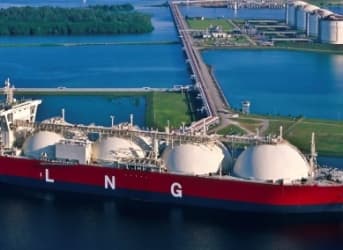Cheniere Energy reached a milestone on February 25, dispatching the first shipment of LNG from its facility at Sabine Pass, Louisiana. The LNG tanker Asia Vision departed the U.S., bound for Brazil. The fact that Petrobras would be the first to benefit from Cheniere’s operations speaks to the confused state of the world gas market, the diminished expectations of those who predicted American LNG satisfying markets in Europe and East Asia, and hints at the struggles facing Cheniere and other prospective American LNG shippers in the year ahead.
Gas prices have plunged in Europe and will remain depressed, particularly if Russia decides to cut the price of its gas exports in order to price out U.S. shale producers. The price of gas in Europe has fallen from $11 to $5 mmbtu over the last four years. The spot price in Asia has fallen to 5$ mmbtu, a reduction of nearly 75 percent since 2014. Related: Brazilian Oil Giant Petrobras Could Lose Its Most Valuable Assets
Cheniere maintains that long-term contracts leave it in a strong position to take advantage of its new facility. The contracts are novelties, “take-or-pay” style arrangements that force companies to pay Cheniere even if they don’t take the option to liquefy gas at its plant; the 20-year contracts are expected to yield $2.9 billion. The company invested $34 billion in two LNG facilities at Sabine Pass and Corpus Christi. Shake-ups in leadership at the end of 2015 resulted in the CEO, Charif Souki departing and the board restricting further investment in LNG projects. Souki’s leadership was instrumental in turning Cheniere from an LNG importer to a company well-positioned to take advantage of the U.S. surge in gas production. He secured contracts with Total, Shell, Korea Gas and the BG Group to fund Cheniere’s investment in LNG exports.
But activist investor Carl Icahn, who purchased a 13.8 percent stake and controls two board seats, felt that Souki needed to go: the CEO’s ambitions were deemed too risky in the current bearish energy market. Cheniere had already posted heavy losses for 2015 and the board, together with Icahn, wanted to finally post a profit for 2016. Souki drew criticism for selling $160 million in Cheniere stock before his departure, though he argued it was merely to reduce his personal stake, which stood at 80 percent of his net worth. Related: Oil Companies On Edge Ahead Of Super Tuesday
Icahn has been pounded in the media for making what many saw as a bad investment. Cheniere’s cash flow by the end of 2015 was negative $357 million, while the company’s stock had depreciated by 61.93 percent over the course of a year. But there’s good evidence to suggest that the company’s share price was seriously over-valued (Jim Chanos’ famously shorted it in August).
Recent publications have mused on the competition between Cheniere and its former CEO. Souki announced plans to build a new LNG facility on a 650-acre lot near the Calcasieu River and hopes to construct LNG tankers that carry .67 million tpy (unlike the Cheniere tankers which carry 4.5 million tpy). Both Souki and Icahn remain convinced, it seems, that LNG is a good bet.
The U.S. faces stiff competition in the race to raise LNG exports. Australia is poised to challenge the U.S. with six new LNG terminals by 2020, including the $54 billion Gorgon project, the world’s most expensive natural gas facility. Australian gas is closer to markets in Asia, and with the continual delays in opening new terminals (Sabine Pass came on several months late, while Corpus Christi is expected to begin deliveries in 2019, once its three trains are constructed), Australia will be able to secure contracts first. Related: Bond Markets Losing Faith Even In Large Oil Companies
Cheniere therefore faces stiff competition, at a time when natural gas demand looks to remain sluggish. The IEA has estimated that while gas demand will double by 2040, LNG demand will increase by 50percent over the next five years. But supply is expected to outstrip demand, with the U.S. and Australia accounting for 90 percent of new LNG supply: 10 bcf/day and 13 bcf/day, respectively, by 2020. Gas demand will pick up relative to energy demand, as gas is expected to make up a larger proportion of overall energy use by 2020, but the IEA revised its forecasts downwards last July, to compensate for lower Asian demand.
Cheniere now possesses profit-producing assets and can take advantage of the contracts won during the Souki era. Between internal divisions, competition both from Australia and its former CEO, and the anemic state of the gas market it remains to be seen whether Cheniere will be able to capitalize on its historic achievement. But if any U.S. company can take advantage of the rising potential of LNG, it’s Cheniere.
By Gregory Brew for Oilprice.com
ADVERTISEMENT
More Top Reads From Oilprice.com:
- The U.S. Still Dominates World Oil Prices
- Australia’s $54 Billion Gas Project Starts Shipping
- Gulf Stock Markets Feel The Pain From Low Oil Prices


















